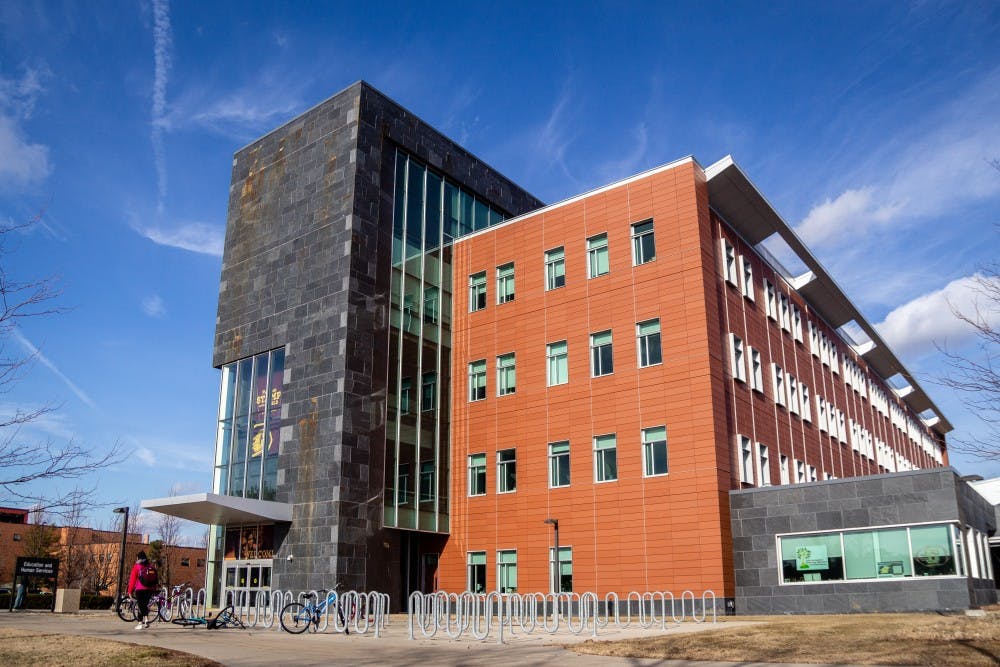CEHS teacher education enrollment rises as result of elimination of exam

The Education and Human Services building stands on April 3 on the campus of Central Michigan University. (File Photo)
The United States currently has a critical demand for teachers.
“On any given day in the schools in the United States, there is a shortage of teachers,” said Betty Kirby, dean of the College of Education and Human Services.
During a time of such desperate need for educators, the College of Education and Human Services admitted about 150 more students during the 2017-18 academic year than in 2016-17. The college hopes for the program to continue to grow in the future.
Increase in education majors
The increase in the number of teaching majors was largely a result of the Michigan Department of Education no longer requiring a rigorous admissions test for the teacher education program.
The Professional Readiness Exam began in 2013, Kirby said. Students needed to pass this exam before they could begin taking teacher education courses. It consisted of three sections: Reading, writing and mathematics. Overall, the exam only had about a 25 percent pass rate.
"At a time when we were already seeing less individuals interested in teaching careers, (the exam) just killed it," Kirby said.
The state stopped requiring this exam in 2017, switching to SAT minimum scores, which led to a large increase in the next cohort of teachers.
During the 2016-17 academic year, the school only admitted 261 students to the education program. That number jumped to 409 students in the 2017-18 academic year.
As of June 2018, the state of Michigan no longer requires any basic skills test to admit a student to a teacher education program at a university. However, the college still has its own criteria and high standards for admitting students into the education program, Kirby said.
Talk gives teaching a bad reputation
Shannon Ebner, the associate director of professional education, Jennifer Klemm, CEHS assistant director of planning and research, and Kirby all hope that the enrollment in the education program continues to rise. However, Kirby believes that rhetoric regarding teaching hurts the profession and needs to change.
“We are working with our nation’s most precious resources—their children,” Kirby said. “I can’t think of a higher calling than to be an educator, and why nationally there has been so much bashing of teachers, I continue to shake my head and wonder, 'What are you doing to the profession?'”
For example, Ebner said that sometimes people refer to teachers as glorified babysitters. This lack of respect toward teachers can deter a student from choosing this career path.
Kirby also said that the low wages a teacher receives can turn people away from this job. The average starting salary for Michigan teacher is $36,620, according to the National Center for Education Statistic.
Kirby, Ebner and Klemm all agree that teacher salaries need to be higher than their current state because teachers need to be able to support themselves and their families.
Other negative talk revolving teachers is teacher burnout. A doctoral study from Walden University explains that many teachers experience burnout and leave the profession because they are overwhelmed by the workload or feel as if they aren't respected.
According to the National Education Association, 40 percent of new teachers will leave the profession within the first five years. Kirby believes burnout can be diminished, though, by being prepared.
However, Kirby further explained that when incoming teacher education students constantly hear that they will make no money or will be burnt out after a few years, they will not even want to think about the field.
CEHS programs help students succeed
For students that are interested in the profession, CEHS hopes to attract high school students to the career through their own program.
The "Cadet Teaching Academy" is a program meant to recruit high school students interested in teacher education. The program is set up so that if a high schooler completes two years of the program and gets a B or higher, they automatically come into CMU with credit for the introductory education class, EDU 107, Ebner said.
The college has also increased its recruiting by visiting more high schools around the state, Ebner said.
For prospective students, Kirby emphasized that getting a teaching degree does not just mean that the student will end up working as a teacher in the public school system. They could end up as administrators or teaching courses for business.
“Educators are valuable,” Kirby said. “There are many people who want to hire them.”
For students who are already enrolled in the education program at CMU, the college tries to provide resources and opportunities other than student teaching that get students to experience in the field.
One program CEHS has established is the class "Art in the Elementary School." During the course, students are able to create lesson plans and teach students in summer or after-school program called Partners Empowering All Kids.
“The students that are taking ART 345 are able to go in and teach those students what they’ve been learning in the classroom and have that hands-on experience,” Ebner said.
A way that the college is addressing the issue of burnout is by implementing professional development experiences.
“(We are) creating that awareness, so a student knows with this profession that (burnout) is possible and that you have to probably do some things to make sure that that doesn’t happen,” Kirby said.
The professional development experiences focus both on self-care and the emotions that children might bring to the classroom. These opportunities have been powerful for students and help prepare them for emotional stress they may face, Klemm said.






